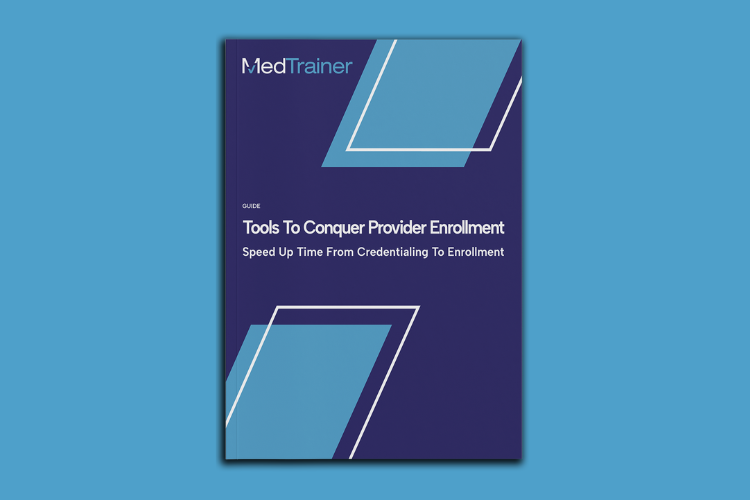Healthcare organizations and providers must undergo credentialing to bill for medical services. The credentialing workflow process can take 120 days or longer since it thoroughly confirms a provider’s background and qualifications. Delays can happen for many reasons, and each day a provider lacks enrollment with one payer, it’s estimated that an organization loses $9,000 of potential revenue.
Medical and insurance credentialing is required before a provider starts employment. Organizations must follow steps of the credentialing workflow in a specific order to prevent delays or rejection by insurance carriers of in-network coverage. Although several mishaps can occur during credentialing, I find there are many ways to combat these errors and expedite the process as much as possible.
Strategies To Improve Credentialing Workflow Efficiency and Accuracy
On average, credentialers must gather 30 documents per provider to complete one enrollment. Minor interruptions, missing information and documents, and sometimes sluggish insurance payers can delay the credentialing workflow. Imagine if these delays occurred for every provider, causing a loss of revenue and frustration for all parties involved. Here are some strategies to optimize credentialing workflow efficiency and accuracy:
- Expedite the initial process: Once a provider has signed their employment contract, electronically request the required documents and forms immediately. As documents are completed and returned, review the information for accuracy and omissions promptly. If you wait to review information right before submission, you may have to contact the provider for additional particulars, causing delays.
- Complete primary source verification: Complete primary source verification to verify and confirm the accuracy of a provider’s qualifications and credentials. It’s a more expeditious process, reduces the risk of errors, and increases the likelihood of quicker approval.
- Review upcoming expirations: Check the expiration dates of provider licensures and certifications as soon as they’re submitted. If they expire within the next few months, ask the provider to apply for renewal early and submit the updated document as soon as they receive it. Notify insurance carriers of the expected update, and once the renewal is received, update the records to reflect the change.
- Record progress: It’s helpful to use an enrollment application checklist to stay on track and always know the next step. Quickly identify missing documents with enhanced credentialing reporting.
- Schedule regular reminders: Oftentimes, you’ll have to follow up regarding a provider’s credentialing and insurance payer enrollment status. Use credentialing software that offers automatic reminders and schedule weekly update emails for the provider and credentialing team. Make phone calls when necessary to get status updates, especially when you haven’t had an update in over two weeks.
- Double-check information: Always double-check information for errors and omissions before submission. Consider asking another credentialing specialist to cross-check documents as well. A second set of eyes can reduce the likelihood of mistakes.
- Create a CAQH profile: Ask the provider to create a CAQH Provider Data Portal and enter the requested information. Building a CAQH profile streamlines the credentialing process since it’s a central location that manages and shares provider information with multiple organizations. Requesting organizations promptly receive notifications and updates on provider information.

Get the tools you need to eliminate delays in your provider enrollment process.
Expedite Processes Using Credentialing Software
Credentialing hiccups and delays are common and can cause substantial loss of organizational revenue. Streamline the credentialing workflow with software designed to speed up the process.
Provider Data and Documents in One Place
Digital credentialing platforms store documents, data, and communications in a provider profile for easy access and visibility. Send providers a link to upload documents directly to a secure portal, complete with automatic reminders until all required documents have been received.
Knowledgeable of State and Compliance Regulations
States, credentialing organizations, and insurance payers have different regulatory and compliance standards. Use credentialing software to take the guesswork out of these small nuances. Check and get instant notifications of exclusions, easily verify provider licenses, and receive reminders of upcoming expirations.
Credentialing Software Subject Matter Experts
Credentialing software specializes in provider credentialing and enrollment. Software crafted and backed by those with credentialing expertise provides high-quality standards, leaving little room for potential error. Easily manage your organization’s provider network, including initial and re-credentialing.
Save Time and Money With MedTrainer Credentialing
Built-in automation, real-time reporting, and proven workflows save organizations time and money. Most credentialing specialists need 4 to 8 hours of uninterrupted time to enroll a provider with one payer. A provider may require 10 payer enrollments, which adds up to 40 to 80 hours spent on one provider.
Partner with MedTrainer to save time and money. Watch how MedTrainer can accelerate the credentialing process.
